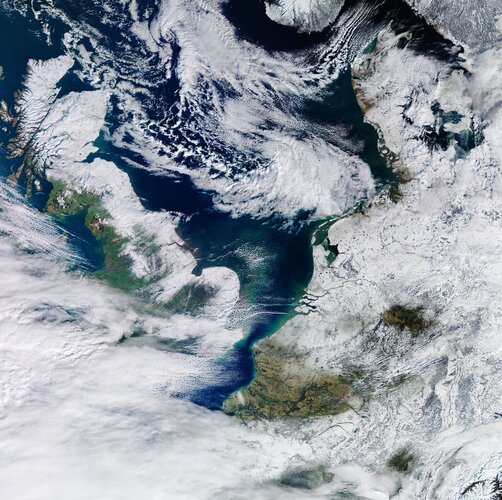As this image captured today, 11 February, by Copernicus Sentinel-3 shows, the Netherlands remains pretty much snow-covered thanks to days of sub-zero temperatures following the country’s first major snowstorm in a decade.
Storm Darcy hit the Netherlands in the evening of Saturday 6 February as it pushed its way through much of northern Europe. Strong winds and bitter cold, which initiated a ‘code red’ weather warning, brought the country to an almost standstill as most public transport was cancelled the following day – by which time most of the country was under around 10 cm of snow. The snowfall also caused disruption to parts of the UK and Germany.
Although the snow stopped falling a day or so later, temperatures have remained below freezing, reawakening the Dutch passion for ice-skating. The Netherlands is home to the century-old ‘Elfstedentocht’, a 200-kilometre race on natural ice through 11 towns and cities in the northern province of Friesland. It was last held in 1997, but the current Covid pandemic restrictions mean that this historic race, which can attract thousands of participants and hundreds of thousands of spectators, is not permitted this year.
Climate change is thought to be having an impact on the chances of conditions being right for an Elfstedentocht – the canal ice has to be at least 15 cm thick. According to the Dutch Meteorological Institute, KNMI, a century ago, there was a 20% chance every year of it being cold enough to organise the race, this has now decreased to an 8% chance.
Copernicus Sentinel-3 is a two-satellite mission to supply the coverage and data delivery needed for Europe’s Copernicus environmental monitoring programme. Each satellite carries the same suite of four sensors. This image, showing snow cover in the Netherlands, Denmark, part of the UK and part of Germany, was captured by the mission’s ocean and land cover instrument.



 Image:
As this Copernicus Sentinel-3 image captured today shows, the Netherlands remains pretty much snow-covered thanks to days of sub-zero temperatures following the country’s first major snowstorm in a decade.
Image:
As this Copernicus Sentinel-3 image captured today shows, the Netherlands remains pretty much snow-covered thanks to days of sub-zero temperatures following the country’s first major snowstorm in a decade.